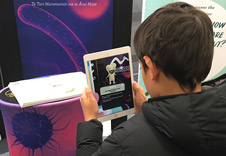Thursday 12 July 2018 8:52pm

The AR experience in action.
A captivating augmented reality (AR) experience, aimed at enthusing eight- to 12-year-olds about gut microbiomes, was one of many successful exhibits at the University of Otago Science Expo, held last weekend as part of the New Zealand International Science Festival.
Thousands of children passed through the Expo, held in the St David Theatre complex, which featured interactive displays from across the University’s Sciences and Health Sciences Divisions.
The Microbiome Otago exhibit was the brainchild of the Department of Microbiology and Immunology’s Professor Gerald Tannock, who commissioned the project to help excite and educate children.
“There are 20 trillion microbes living in our bodies – that’s at least as many as there are cells. These organisms are fascinating and so important to our health. But it was a real challenge to teach such a complex concept to children and inspire them to learn more” he says.
"I didn’t really know what AR was, or how it could help teach about microbiota … now I can see its educational potential!."
So, Professor Tannock employed the expertise of Nathan Martin, an alumnus of University of Otago’s Design department and Director of Moving Pixel Ltd.
Together they created an AR experience – combining a poster and smart device app.
The project features a handful of strange but cute microbiome characters that pop into 3D action, complete with narration describing their traits. Participants download a free app on their smart device and point it at a poster. That triggers the augmented reality (AR) and interactive 3D characters that teach, while delighting their audience.
The posters are free to download from the Microbiome Otago website and Professor Tannock hopes schools around New Zealand make the most of the resource.
“I didn’t really know what AR was, or how it could help teach about microbiota … now I can see its educational potential!” Professor Tannock says. “I encourage all schools to have some fun with this resource – it’s such an accessible way to teach about microbes.”
Other displays included the Brain Health Research Centre’s giant inflatable brain, a Human Nutrition activity to guess the fat and sugar contents of some common foods and drinks, Zoology’s real bumble bee nest, and many more.
